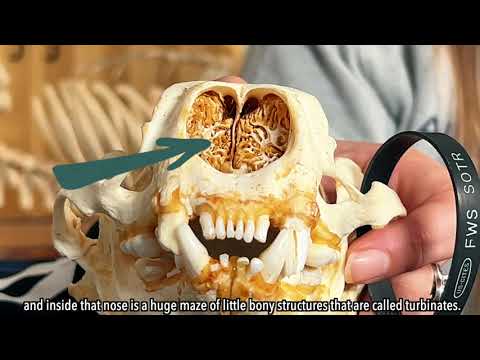Summary:
1. The Importance of Nasal Turbinates: Exploring the function and structure of nasal turbinates in otters and other arctic species.
2. Adaptations for Cold Environments: Discover how nasal turbinates help otters thrive in icy waters.
3. Unique Features of Sea Otters: Learn about the specialized nasal turbinates in sea otters and their role in diving.
4. Nasal Turbinates in Other Arctic Species: Explore how different arctic animals utilize nasal turbinates to survive in extreme conditions.
5. Virtual Visit: Join us on a fascinating virtual tour to witness the incredible adaptations of otters and other arctic creatures.
Welcome back to Part 3 of our captivating series on otter bones. In this edition, we delve into the intriguing world of nasal turbinates and explore their unique role in the lives of these charismatic sea creatures. But before we dive in, we want to express heartfelt gratitude to Royal Caribbean Group, our generous sponsor, for making this virtual visit possible!
1. The Importance of Nasal Turbinates
Nasal turbinates may sound complex, but in simple terms, they are intricate bony structures found in the nasal cavities of various animals, including sea otters. These delicate and convoluted scroll-like bones serve essential functions, such as filtering, warming, and humidifying our air.
In the case of otters, nasal turbinates play a crucial role in adapting to their unique aquatic lifestyle. As air-breathing mammals, otters rely on their nasal turbinates to condition the cold, damp air they inhale while submerged underwater. The turbinates help trap moisture and heat, ensuring the otter’s delicate respiratory system stays protected, even in frigid waters.
2. Adaptations for Cold Environments
Living in icy waters requires exceptional adaptations, and sea otters possess a few tricks up their furry sleeves. Their dense fur, waterproof thanks to the presence of specialized guard hairs and a layer of air trapped within, provides insulation against the numbing cold. However, it is the nasal turbinates that truly make a scientific splash.
Through their impressive structure, nasal turbinates maximize the surface area within the otter’s nasal cavity. This increased surface area allows for more efficient heat and moisture exchange, preventing the delicate lung tissue from chilling or drying out. The intricate scroll-like pattern of the nasal turbinates also creates turbulence, ensuring a longer exposure of inhaled air to the nasal surfaces, further enhancing the conditioning process.
3. Unique Features of Sea Otters
Sea otters, unlike their river otter cousins, spend most of their lives in the open ocean. Therefore, their nasal turbinates have evolved specific adaptations to cope with the challenges of a marine environment.
The nasal turbinates in sea otters are larger compared to their river-dwelling relatives. This modification helps sea otters extract more oxygen from the inhaled air, compensating for the reduced oxygen levels in seawater. By maximizing the efficiency of oxygen extraction, sea otters can engage in prolonged dives, reaching impressive depths and enduring longer periods underwater in search of prey.
4. Nasal Turbinates in Other Arctic Species
While otters steal the spotlight with their impressive nasal turbinates, they aren’t the only arctic inhabitants with this fascinating adaptation. Other cold-adapted species, such as polar bears, seals, and even certain species of birds, have nasal turbinates tailored to their specific needs.
These animals have finely tuned nasal turbinates that aid in trapping moisture and warming the air they breathe. Polar bears, for instance, possess large nasal turbinates that allow them to heat the frigid air, conserving vital body heat in their harsh Arctic environment. Similarly, seals depend on their nasal turbinates to conserve moisture and warm up the chilled air, ensuring their respiratory systems remain protected during dives beneath the icy surface.
5. Virtual Visit: A Fascinating Encounter
Now that we’ve explored the remarkable world of nasal turbinates let’s embark on a virtual visit to witness these adaptations firsthand. Join us as we journey to the frigid waters of the Arctic, where sea otters gracefully glide through the icy depths, their complex nasal turbinates working tirelessly to condition the air they breathe.
Our virtual tour will also introduce you to other awe-inspiring arctic creatures, each equipped with a unique set of adaptations to survive in this extreme environment. From the magnificent polar bear, master of its frozen domain, to the sleek and agile seals, we’ll unravel the mysteries behind their nasal turbinates and their role in their survival.
Throughout this virtual visit, you’ll witness the strength, resilience, and adaptability of these remarkable creatures. It’s an opportunity to gain a deeper appreciation for the intricate web of life that exists in our vast and diverse natural world.
In conclusion, the nasal turbinates of otters and other arctic species offer a fascinating glimpse into the remarkable adaptations that enable these creatures to thrive in challenging environments. From regulating moisture and temperature to maximizing oxygen extraction, these intricate structures truly showcase the wonders of evolutionary biology. So, join us on this virtual adventure and prepare to be captivated by the wonders of nature as we continue to uncover the secrets hidden within otter bones.
*****
Source Description
Ok… this week’s Virtual Visit is pretty fascinating 💀
Did you know sea otters and other arctic species have intricate nasal turbinates?
This “Virtual Visit” episode is made possible by the generous support of our sponsors. Thank you, Royal Caribbean Group, for making this free program possible!


